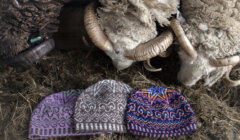Business / Sheep scab identified in imported ram
OFFICERS from the council’s environmental health team are working with crofters and farmers to prevent the spread of sheep scab after the first case in almost 30 years was identified in a ram recently imported.
The animal was treated for scab with a Cydectin injection at the pier, as is usual practice to keep the isles clear of the highly infectious disease, but this appears to have been ineffective.
Resistance in animals against this treatment has been spreading through the UK, and there is growing concern among the farming community that this could become a more widespread problem.
Officers said the prompt action of the owner, after recognising potential signs of scab in the imported ram and arranging for necessary testing, has enabled the infection to be identified and action taken to protect other Shetland flocks.
However, the infection has spread to other animals on the holding. The flock directly affected, and those neighbouring, will be treated by dipping.
Farmers and crofters who have imported sheep which travelled up in the same container as the infected ram have been notified, and testing will be undertaken to identify any infection.
The council’s veterinary advisor Hillary Burgess said officers have been in touch with owners of immediate contacts to make them aware of the situation and initial testing and treating requirements.
Owners must ensure all sheep on the holding are presented for treatment. A diagnosis or suspicion of sheep scab is notifiable in Scotland.
“Sheep scab is now in Shetland, and we’d ask that farmers and crofters are extremely vigilant,” Burgess said.
“Early signs are rubbing, scratching, biting at flanks, and tags of fleece pulled out. These signs can very much resemble lice infections.
Become a member of Shetland News
“In more advanced disease, areas of bare and raw red skin or scabs become visible and there is also weight loss. Those with a keen eye may be able to see mites visible at the edge of these raw patches.
“This disease spreads extremely rapidly by direct contact, sheep to sheep, and the mites can survive for up to three weeks off the animal. Mites can survive on fence posts, on handling systems, in trailers and particularly in tags of wool.”
She added: “As a precaution, sharing of equipment between flocks should be kept to a minimum and equipment should be thoroughly cleaned and disinfected between holdings.
“The use of separate protective clothing is also strongly recommended when working on different flocks or, at the very least, careful cleaning and disinfection of clothing between flocks.
“We are asking farmers and crofters to be aware that sheep scab is now on Shetland and to take appropriate precautions. By working together as a community we can rid Shetland of this disease once again.”
Anyone with any concerns should contact Shetland Vets on 01595 810456.
Become a member of Shetland News
Shetland News is asking its many readers to consider paying for membership to get additional features and services: -
- Remove non-local ads;
- Bookmark posts to read later;
- Exclusive curated weekly newsletter;
- Hide membership messages;
- Comments open for discussion.
If you appreciate what we do and feel strongly about impartial local journalism, then please become a member of Shetland News by either making a single payment, or setting up a monthly, quarterly or yearly subscription.















































































